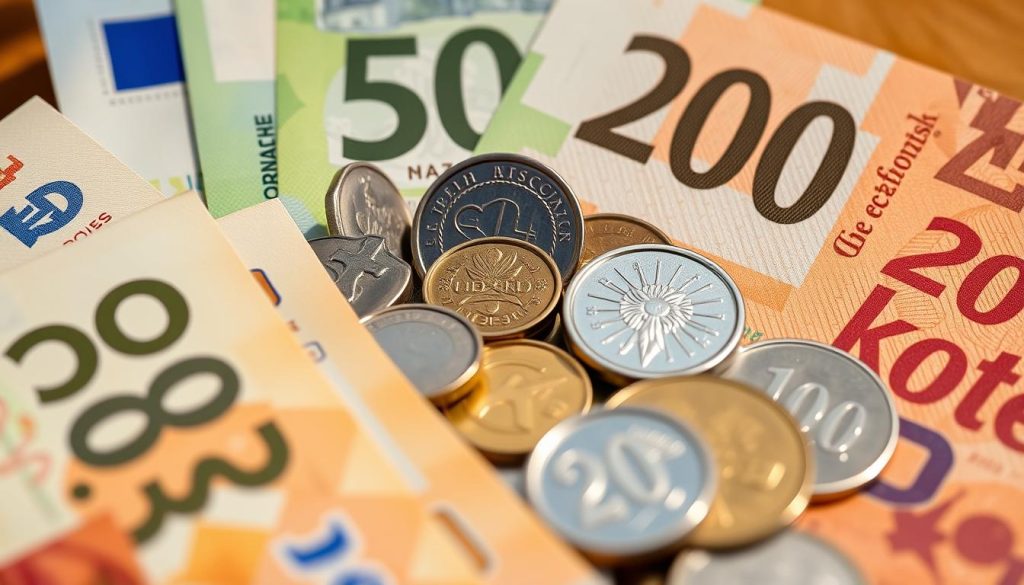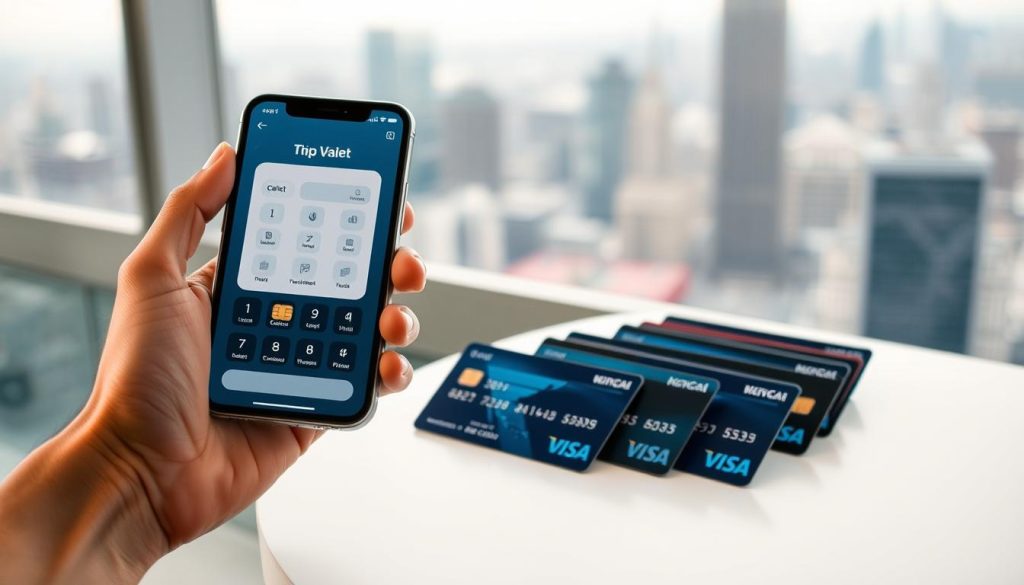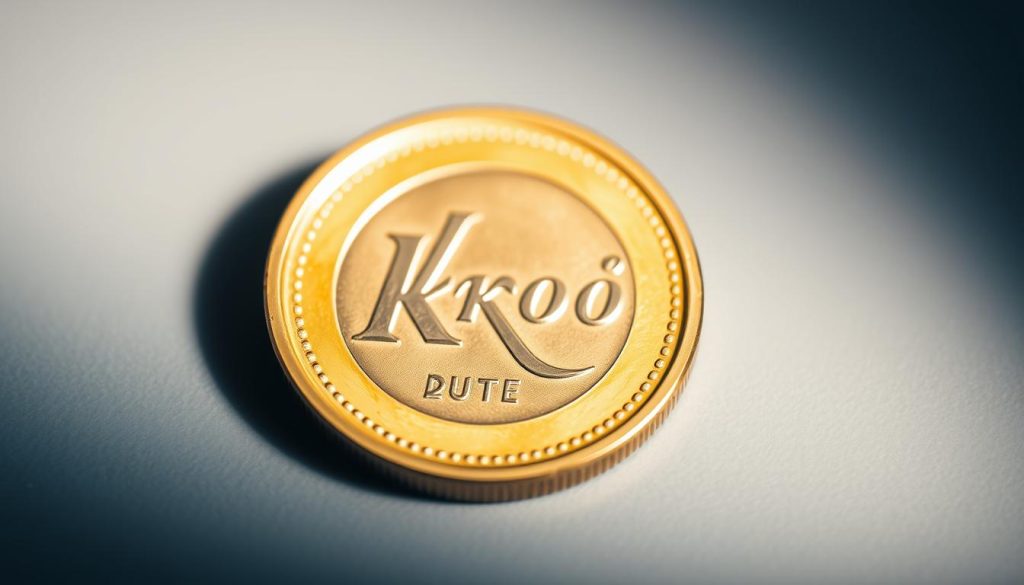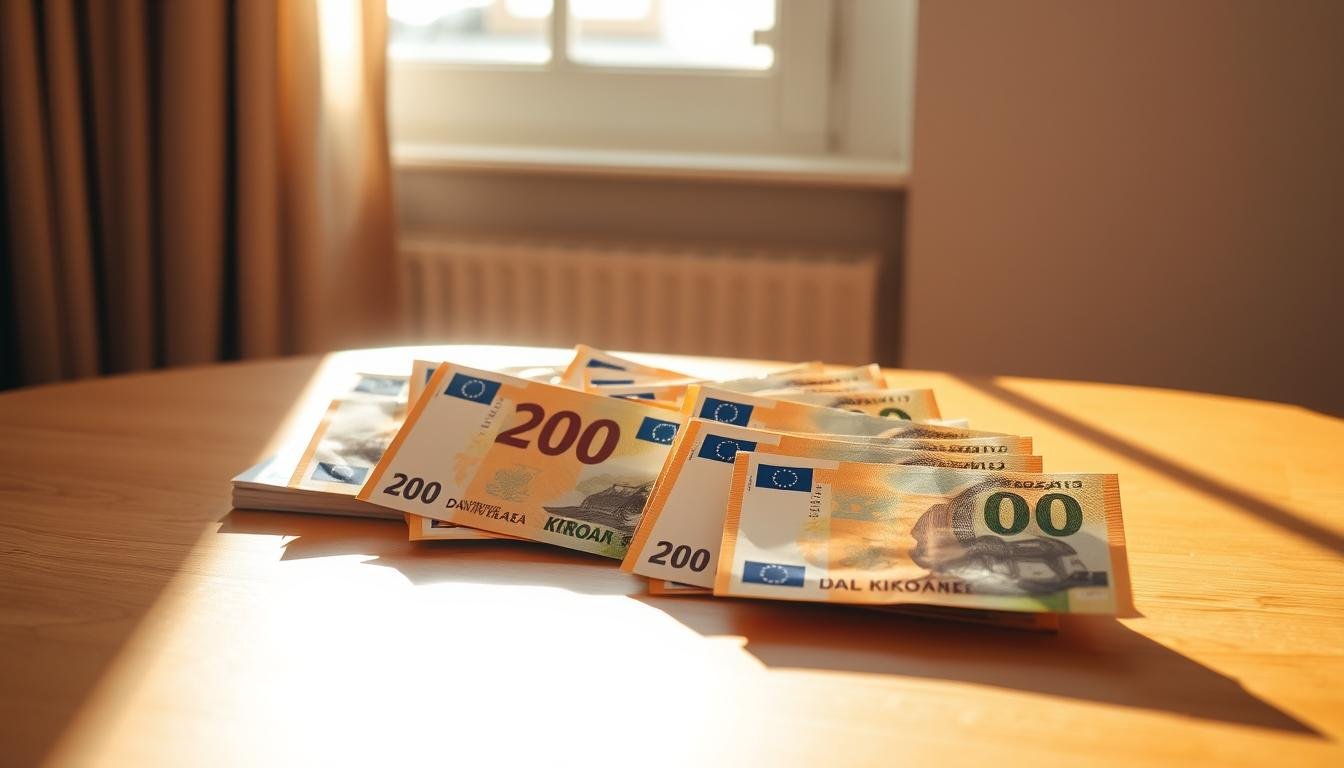Did you know that the Danish krone has been Denmark’s official currency since 1875? With its rich design and cultural significance, it’s more than just money—it’s a piece of history. If you’re planning a trip, understanding the exchange rate is crucial. For example, the mid-market rate is approximately 0.92275 USD to DKK, but rates at airports or hotels can be much worse.
This guide is here to help you navigate the local currency and avoid unnecessary fees. You’ll learn why knowing the exchange rate matters and how tools like the Wise debit card can save you money. Whether you’re exploring cities or rural areas, having a mix of cash and cards ensures flexibility.
From historical insights to modern tips, this guide prepares you for a seamless experience. Ready to dive in? Let’s get started!
Introduction to Danish Currency and Payment Methods
Understanding the local currency is the first step to a smooth trip. The Danish krone (DKK) is the official currency, and knowing how to use it can save you time and money. Whether you’re shopping, dining, or exploring, having the right payment method is essential.
Setting the Stage for Your Journey
Before you arrive, it’s important to familiarize yourself with the basics. The DKK comes in colorful banknotes and coins, each with its own unique design. While cards are widely accepted, carrying some cash ensures you’re prepared for smaller transactions or rural areas.
Monitoring the exchange rate is crucial. The mid-market rate is the fairest, but many services add extra fees. Avoid airport exchanges, as they often offer poor rates. Instead, use local ATMs or reliable currency exchange services.
Why Currency Knowledge Matters
Knowing the exchange rate helps you avoid unnecessary fees. For example, using a card with no foreign transaction fees can save you up to 3% on every purchase. Additionally, understanding the DKK ensures you’re not overpaying for goods or services.
Here’s a quick comparison of payment methods:
| Payment Method | Pros | Cons |
|---|---|---|
| Credit Card | Widely accepted, secure | May have foreign transaction fees |
| Debit Card | Convenient for ATM withdrawals | Limited daily withdrawal amounts |
| Cash | Accepted everywhere, no fees | Risk of loss or theft |
“The more you know about the local currency, the better prepared you’ll be for your trip.”
By combining cards and cash, you’ll have the flexibility to handle any situation. Start your journey with confidence by mastering the basics of Danish payments.
Understanding the Danish Krone (DKK)
Every coin and banknote of the Danish krone tells a unique story. From its intricate designs to its cultural symbolism, the DKK is more than just a means of exchange—it’s a window into Denmark’s heritage. Whether you’re a first-time visitor or a seasoned traveler, understanding the currency will enhance your experience.

Denominations and Design
The Danish krone comes in both coins and banknotes, each with distinct features. Coins range from 50 øre to 20 kroner, while banknotes include 50, 100, 200, 500, and 1000 kroner. The designs celebrate Denmark’s history, featuring iconic bridges, historical figures, and cultural landmarks.
For example, the 100-kroner note showcases the Great Belt Bridge, symbolizing connection and progress. These elements make the currency not just functional but also a piece of art. Carrying a mix of cash ensures you’re prepared for small purchases or places where cards aren’t accepted.
Cultural and Historical Significance
The Danish krone has roots dating back to the Scandinavian Monetary Union in the 19th century. This historical background influences its design and value today. The currency reflects Denmark’s commitment to preserving its identity while embracing modernity.
For tourists, understanding this history adds depth to your travels. It’s also practical to know where to withdraw money. ATMs are widely available in cities and tourist areas, offering a convenient way to get cash in DKK. Always check for fees to avoid unnecessary costs.
| Denomination | Design Feature | Significance |
|---|---|---|
| 50 kroner | Sallingsund Bridge | Represents engineering achievements |
| 100 kroner | Great Belt Bridge | Symbolizes connection and progress |
| 500 kroner | Queen Margrethe II | Highlights Danish monarchy |
By familiarizing yourself with the Danish krone, you’ll not only manage your transactions smoothly but also gain a deeper appreciation for the country’s culture. Whether you’re admiring the designs or using ATMs, the DKK is an integral part of your journey.
Navigating the USD to DKK Exchange Rate
Managing your money wisely starts with understanding the exchange rate. The mid-market rate is the fairest benchmark, often found on platforms like Google. However, marked-up rates are common, especially at airports. Knowing how to compare rates can save you money and make your trip more enjoyable.
What is the Mid-Market Exchange Rate?
The mid-market rate is the rate banks use to trade currencies among themselves. It’s the fairest way to exchange money because it doesn’t include extra fees. For example, if you’re converting USD to DKK, this rate ensures you get the most value for your spending.
Dynamic currency conversion, on the other hand, often includes hidden fees. This happens when a merchant or ATM offers to charge you in your home currency. While it seems convenient, the exchange rate is usually worse than the mid-market rate.
Comparing Rates for Better Deals
Airport exchanges are notorious for poor rates. They often charge high fees, making them an expensive way to get cash. Instead, use local ATMs or reliable exchange services for better deals. Always check the mid-market rate before making a purchase or exchanging money.
Here’s a quick comparison of exchange options:
- Airport Exchanges: High fees, poor rates.
- Local ATMs: Better rates, but check for withdrawal fees.
- Online Services: Often offer competitive rates with low fees.
“The mid-market rate is your best friend when exchanging currency. Always compare rates to avoid unnecessary costs.”
By understanding these nuances, you can make informed decisions and stretch your budget further. Whether you’re planning your trip or already on the go, knowing the exchange rate is a smart way to manage your spending.
Helpful Tips for Exchanging Money in Denmark
Exchanging money efficiently can make your trip stress-free and budget-friendly. By following a few simple strategies, you can avoid unnecessary fees and get the most value for your spending. Here’s how to navigate the process like a pro.

Best Practices to Avoid High Fees
One of the easiest ways to save money is by using a travel debit card or withdrawing from an ATM. These methods often provide rates closer to the mid-market rate, without hidden commissions. Always check for fees before making a transaction.
Platforms like Wise and providers like Travelex are great options for competitive rates. They offer transparency and low fees, making them a reliable choice for travelers. Avoid airport exchanges, as they typically charge higher fees and offer less favorable rates.
Where to Find Competitive Exchange Rates
Local ATMs are a convenient way to get cash in the local currency. They usually offer better rates than currency exchange kiosks. Look for ATMs affiliated with major banks to minimize withdrawal fees.
Online services like Wise are another excellent option. They allow you to hold and exchange multiple currencies at the mid-market rate. This flexibility ensures you get the best value for your money.
“Always compare rates before exchanging money. A little research can save you a lot in fees.”
Here’s a quick comparison of exchange options:
| Option | Pros | Cons |
|---|---|---|
| ATM Withdrawals | Better rates, convenient | Possible withdrawal fees |
| Online Services (e.g., Wise) | Low fees, mid-market rates | Requires advance planning |
| Airport Exchanges | Immediate access | High fees, poor rates |
By choosing the right option, you can keep your money’s value intact and enjoy a hassle-free trip. Whether you’re using a debit card or withdrawing from an ATM, these tips will help you make the most of your currency exchange.
Payment Options for Travelers in Denmark
Choosing the right payment method can make your trip smoother and more enjoyable. Whether you’re dining at a local café or shopping for souvenirs, having the right mix of options ensures flexibility. In this section, we’ll explore the pros and cons of using cards and cash, along with tips to avoid unnecessary fees.
Using Debit and Credit Cards
Cards are widely accepted in most places, making them a convenient choice. Debit cards are great for ATM withdrawals, while credit cards offer added security for larger purchases. However, watch out for foreign transaction fees, which can add up quickly.
Some providers, like Wise, offer cards with low or no transaction fees. These can save you money on every purchase. Contactless payments are also popular, allowing for quick and easy transactions. Just ensure your card is enabled for international use before you travel.
The Importance of Carrying Cash
While cards are convenient, cash is still essential in certain situations. Small purchases, local markets, and tips often require cash. Carrying a small amount ensures you’re prepared for these scenarios.
ATMs are widely available, but check the cost of withdrawals. Some banks charge high fees, so using a low-cost ATM card can save you money. Always withdraw in the local currency to avoid poor exchange rates.
“Balancing cards and cash is the best way to handle any payment situation during your travels.”
Here’s a quick comparison of payment methods:
| Payment Method | Pros | Cons |
|---|---|---|
| Debit Card | Convenient for ATM withdrawals | Possible withdrawal fees |
| Credit Card | Secure, widely accepted | Foreign transaction fees |
| Cash | Accepted everywhere, no fees | Risk of loss or theft |
By combining cards and cash, you’ll have the flexibility to handle any situation. Choose the right provider to minimize fees and make the most of your spending. With a smart payment strategy, you can focus on enjoying your trip without worrying about unnecessary costs.
Using Mobile Payments and Travel Debit Cards
Mobile payments are transforming how we handle transactions while traveling. They offer convenience, security, and real-time management of your funds. Whether you’re using a travel debit card or a mobile app, these tools ensure you stay in control of your spending.

Travel debit cards like Wise are particularly popular for their low-cost currency conversion and flexibility. They allow you to lock in the mid-market rate, saving you money on every transaction. Additionally, mobile payment apps like MobilePay are widely used, making it easy to split bills or pay for small purchases.
Benefits of the Wise Card
The Wise card is a game-changer for travelers. It offers locked-in rates, ensuring you get the best price for your currency conversions. With features like free withdrawals up to 200 GBP per month, it’s a cost-effective way to manage your bank account while abroad.
Another advantage is its real-time tracking. You can monitor your spending and exchange rates instantly. This helps you make sure you’re staying within budget. Plus, the card supports multiple currencies, making it ideal for frequent travelers.
Alternative Mobile Payment Solutions
In addition to travel debit cards, apps like MobilePay and ViaBill are popular in the region. MobilePay allows for quick and secure card payments, while ViaBill lets you split purchases into interest-free installments. These options provide flexibility for different spending needs.
For those who prefer traditional methods, N26 offers free withdrawals and no foreign transaction fees. It’s a reliable alternative to bank cards, especially for those who travel frequently. Always compare options to make sure you’re getting the best deal.
| Payment Option | Key Features | Best For |
|---|---|---|
| Wise Card | Locked-in rates, free withdrawals | Frequent travelers |
| MobilePay | Quick, secure payments | Small purchases |
| ViaBill | Interest-free installments | Budget-conscious spenders |
| N26 | No foreign transaction fees | Global travelers |
“Mobile payments and travel debit cards simplify your travel finances, ensuring you get the best value for your money.”
By leveraging these tools, you can make sure your transactions are smooth and cost-effective. Whether you’re using a Wise card or a mobile app, these solutions empower you to manage your spending with ease.
Practical Advice on Currency Conversion and Fees
Currency conversion doesn’t have to be a headache if you know the right strategies. Hidden fees and poor exchange rates can eat into your budget, but with a few smart tips, you can avoid unnecessary costs. Whether you’re exchanging money at home or abroad, understanding the process is key to saving money.
Understanding Dynamic Currency Conversion
Dynamic Currency Conversion (DCC) is a service offered by merchants or ATMs that allows you to pay in your home currency instead of the local currency. While it seems convenient, it often comes with hidden fees and poor exchange rates. For example, if you’re charged in USD instead of DKK, the rate might be significantly worse than the mid-market rate.
Always opt to pay in the local currency to avoid these extra charges. This ensures you get the best rate and avoid unnecessary fees. If you’re unsure, ask the merchant or ATM to charge you in the local currency.
Strategies to Minimize Extra Charges
Here are some practical tips to save money during currency conversion:
- Compare Rates: Check the mid-market rate before exchanging money. Use online tools or apps to compare rates from different providers.
- Avoid Airport Exchanges: These often have high fees and poor rates. Instead, use local ATMs or reliable exchange services.
- Use Travel Cards: Cards like Wise offer low-cost conversion and locked-in rates, saving you money on every transaction.
- Plan Ahead: Exchange some money before your trip to avoid rush fees and ensure you have cash on hand.
“Paying in the local currency is the simplest way to avoid hidden fees and get the best exchange rate.”
Here’s a quick comparison of currency conversion methods:
| Method | Pros | Cons |
|---|---|---|
| Airport Exchanges | Immediate access | High fees, poor rates |
| Local ATMs | Better rates, convenient | Possible withdrawal fees |
| Online Services (e.g., Wise) | Low fees, mid-market rates | Requires advance planning |
By following these tips, you can make the most of your money and avoid unnecessary charges. Whether you’re exchanging cash or using a card, these strategies ensure you get the best value for your conversion.
Denmark: Ultimate Travelers Guide to Currencies & Payments
Mastering the basics of Danish payments ensures a smooth and stress-free journey. This guide equips you with the knowledge to handle coins, exchange money wisely, and choose the right payment methods. By integrating these tips, you’ll navigate your trip with confidence and ease.
Recap of Key Insights
Throughout this guide, you’ve learned the importance of understanding the Danish krone. From its unique coin designs to its cultural significance, the currency is more than just a means of payment. You’ve also discovered practical strategies for exchange money at the best rates, avoiding hidden fees, and using cards effectively.
Planning ahead is crucial. Whether you’re researching rates at home or withdrawing cash abroad, preparation saves time and money. By combining cards and cash, you’ll be ready for any situation, from small purchases to larger transactions.
Why Currency Knowledge Matters
Understanding the local currency helps you spend wisely. For example, knowing the mid-market rate ensures you get the best value when exchange money. It also prevents overpaying for goods or services. This knowledge is especially useful in rural areas where card acceptance may be limited.
Carrying coins is essential for small transactions, tips, and local markets. ATMs are widely available, but always check for fees to avoid unnecessary costs. By balancing cards and cash, you’ll have the flexibility to handle any payment scenario.

Practical Tips for a Seamless Experience
Here are some actionable steps to enhance your travel planning:
- Compare Rates: Use online tools to find the best exchange rates before your trip.
- Carry Coins: Keep a small amount of coins for convenience in smaller transactions.
- Use Reliable Cards: Opt for travel debit cards with low or no foreign transaction fees.
- Plan Ahead: Exchange some money at home to avoid rush fees and ensure you have cash on hand.
“A well-prepared traveler knows the value of understanding local payment methods.”
Comparing Payment Options
Here’s a quick overview of the pros and cons of different payment methods:
| Payment Method | Pros | Cons |
|---|---|---|
| Credit Card | Widely accepted, secure | May have foreign transaction fees |
| Debit Card | Convenient for ATM withdrawals | Limited daily withdrawal amounts |
| Cash | Accepted everywhere, no fees | Risk of loss or theft |
By integrating these insights into your travel plans, you’ll enjoy a seamless experience in Denmark. Whether you’re handling coins or using cards, this guide empowers you to make informed decisions and maximize your budget.
Planning Your Currency Strategy for Denmark
Planning your currency strategy can make your trip more cost-effective and stress-free. By understanding your options and preparing in advance, you can avoid unnecessary fees and get the best value for your money. Whether you’re dining at a local restaurant or shopping at a market, a solid plan ensures you’re always ready to pay without hassle.
Booking in Advance vs. Exchanging On Arrival
Exchanging money before your trip has its advantages. You can lock in a favorable rate and avoid the stress of finding a reliable exchange currency service upon arrival. Online platforms like Wise allow you to hold multiple currencies and convert them at the mid-market rate, saving you money.
On the other hand, exchanging on arrival can be convenient, especially if you’re unsure how much cash you’ll need. However, airport exchanges often charge high fees and offer poor rates. Instead, use local ATMs or trusted exchange services for better deals.
Tips for Monitoring Live Exchange Rates
Keeping an eye on live exchange rates helps you make informed decisions. Apps like XE Currency provide real-time updates, ensuring you know the best time to convert your money. This is particularly useful for managing your account balance and optimizing your spending.
Here are some practical tips for monitoring rates:
- Set Alerts: Use apps to notify you when rates reach your desired level.
- Compare Providers: Check rates from different banks and online services to find the best deal.
- Avoid Dynamic Currency Conversion: Always choose to pay in the local currency to avoid hidden fees.
Practical Examples for Everyday Spending
When dining at a restaurant, using a card with no foreign transaction fees is ideal. For small purchases at a market, cash is often more convenient. Carrying a mix of both ensures you’re prepared for any situation.
Here’s a quick comparison of payment options:
| Payment Method | Best For | Tips |
|---|---|---|
| Credit Card | Larger purchases, dining | Check for foreign transaction fees |
| Debit Card | ATM withdrawals, everyday spending | Use low-fee ATMs |
| Cash | Small purchases, markets | Carry small denominations |
“A well-planned currency strategy ensures you get the most out of your travel budget.”
By following these tips, you can manage your account effectively and enjoy a seamless experience. Whether you’re exchanging money in advance or monitoring live rates, preparation is key to a stress-free trip.
Conclusion
A well-planned approach to handling money can make your trip smoother and more enjoyable. Understanding local payment methods and exchange options ensures you avoid unnecessary fees and get the best value for your spending.
Balancing cards and cash is a smart idea. Cards are convenient for larger purchases, while cash is essential for smaller transactions or places where cards aren’t accepted. This flexibility ensures you’re prepared for any situation.
Preparation is key. Whether you’re dining at a hotel or shopping at a local store, knowing your options saves time and money. By adopting these strategies, you’ll enjoy a stress-free and budget-friendly experience.
The above is subject to change.
Check back often to TRAVEL.COM for the latest travel tips and deals.
Here are some Tours & Sightseeing suggestions that might pique your interests!






